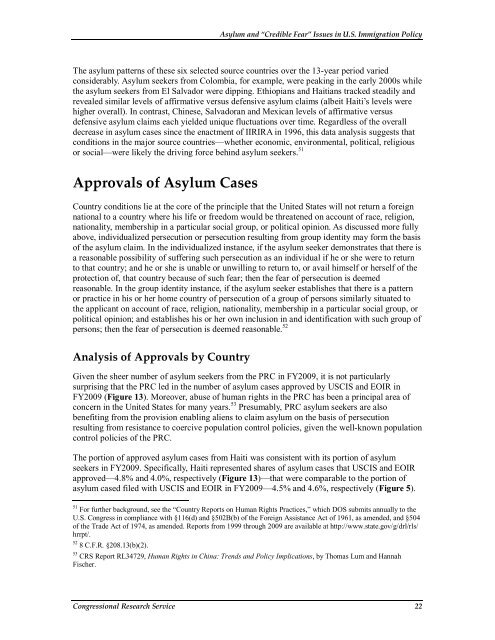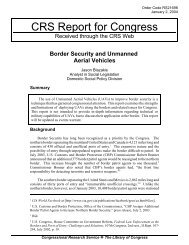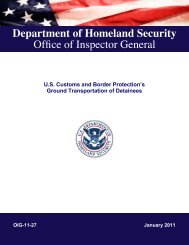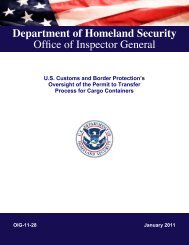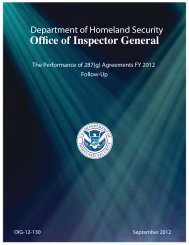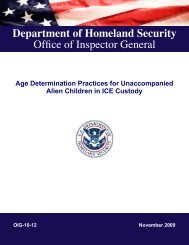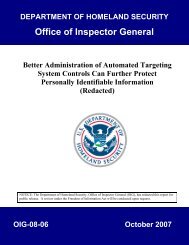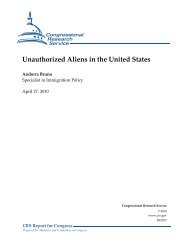Asylum and "Credible Fear" Issues in U.S. Immigration Policy
Asylum and "Credible Fear" Issues in U.S. Immigration Policy
Asylum and "Credible Fear" Issues in U.S. Immigration Policy
You also want an ePaper? Increase the reach of your titles
YUMPU automatically turns print PDFs into web optimized ePapers that Google loves.
<strong>Asylum</strong> <strong>and</strong> “<strong>Credible</strong> Fear” <strong>Issues</strong> <strong>in</strong> U.S. <strong>Immigration</strong> <strong>Policy</strong>The asylum patterns of these six selected source countries over the 13-year period variedconsiderably. <strong>Asylum</strong> seekers from Colombia, for example, were peak<strong>in</strong>g <strong>in</strong> the early 2000s whilethe asylum seekers from El Salvador were dipp<strong>in</strong>g. Ethiopians <strong>and</strong> Haitians tracked steadily <strong>and</strong>revealed similar levels of affirmative versus defensive asylum claims (albeit Haiti’s levels werehigher overall). In contrast, Ch<strong>in</strong>ese, Salvadoran <strong>and</strong> Mexican levels of affirmative versusdefensive asylum claims each yielded unique fluctuations over time. Regardless of the overalldecrease <strong>in</strong> asylum cases s<strong>in</strong>ce the enactment of IIRIRA <strong>in</strong> 1996, this data analysis suggests thatconditions <strong>in</strong> the major source countries—whether economic, environmental, political, religiousor social—were likely the driv<strong>in</strong>g force beh<strong>in</strong>d asylum seekers. 51Approvals of <strong>Asylum</strong> CasesCountry conditions lie at the core of the pr<strong>in</strong>ciple that the United States will not return a foreignnational to a country where his life or freedom would be threatened on account of race, religion,nationality, membership <strong>in</strong> a particular social group, or political op<strong>in</strong>ion. As discussed more fullyabove, <strong>in</strong>dividualized persecution or persecution result<strong>in</strong>g from group identity may form the basisof the asylum claim. In the <strong>in</strong>dividualized <strong>in</strong>stance, if the asylum seeker demonstrates that there isa reasonable possibility of suffer<strong>in</strong>g such persecution as an <strong>in</strong>dividual if he or she were to returnto that country; <strong>and</strong> he or she is unable or unwill<strong>in</strong>g to return to, or avail himself or herself of theprotection of, that country because of such fear; then the fear of persecution is deemedreasonable. In the group identity <strong>in</strong>stance, if the asylum seeker establishes that there is a patternor practice <strong>in</strong> his or her home country of persecution of a group of persons similarly situated tothe applicant on account of race, religion, nationality, membership <strong>in</strong> a particular social group, orpolitical op<strong>in</strong>ion; <strong>and</strong> establishes his or her own <strong>in</strong>clusion <strong>in</strong> <strong>and</strong> identification with such group ofpersons; then the fear of persecution is deemed reasonable. 52Analysis of Approvals by CountryGiven the sheer number of asylum seekers from the PRC <strong>in</strong> FY2009, it is not particularlysurpris<strong>in</strong>g that the PRC led <strong>in</strong> the number of asylum cases approved by USCIS <strong>and</strong> EOIR <strong>in</strong>FY2009 (Figure 13). Moreover, abuse of human rights <strong>in</strong> the PRC has been a pr<strong>in</strong>cipal area ofconcern <strong>in</strong> the United States for many years. 53 Presumably, PRC asylum seekers are alsobenefit<strong>in</strong>g from the provision enabl<strong>in</strong>g aliens to claim asylum on the basis of persecutionresult<strong>in</strong>g from resistance to coercive population control policies, given the well-known populationcontrol policies of the PRC.The portion of approved asylum cases from Haiti was consistent with its portion of asylumseekers <strong>in</strong> FY2009. Specifically, Haiti represented shares of asylum cases that USCIS <strong>and</strong> EOIRapproved—4.8% <strong>and</strong> 4.0%, respectively (Figure 13)—that were comparable to the portion ofasylum cased filed with USCIS <strong>and</strong> EOIR <strong>in</strong> FY2009—4.5% <strong>and</strong> 4.6%, respectively (Figure 5).51 For further background, see the “Country Reports on Human Rights Practices,” which DOS submits annually to theU.S. Congress <strong>in</strong> compliance with §116(d) <strong>and</strong> §502B(b) of the Foreign Assistance Act of 1961, as amended, <strong>and</strong> §504of the Trade Act of 1974, as amended. Reports from 1999 through 2009 are available at http://www.state.gov/g/drl/rls/hrrpt/.52 8 C.F.R. §208.13(b)(2).53 CRS Report RL34729, Human Rights <strong>in</strong> Ch<strong>in</strong>a: Trends <strong>and</strong> <strong>Policy</strong> Implications, by Thomas Lum <strong>and</strong> HannahFischer.Congressional Research Service 22


